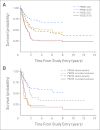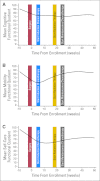Induction chemotherapy and conformal radiation therapy for very young children with nonmetastatic medulloblastoma: Children's Oncology Group study P9934
- PMID: 22851568
- PMCID: PMC3434977
- DOI: 10.1200/JCO.2010.34.4341
Induction chemotherapy and conformal radiation therapy for very young children with nonmetastatic medulloblastoma: Children's Oncology Group study P9934
Abstract
Purpose: P9934 was a prospective trial of systemic chemotherapy, second surgery, and conformal radiation therapy (CRT) limited to the posterior fossa and primary site for children between 8 months and 3 years old with nonmetastatic medulloblastoma. The study was open from June 2000 until June 2006.
Patients and methods: After initial surgery, children received four cycles of induction chemotherapy, followed by age- and response-adjusted CRT to the posterior fossa (18 or 23.4 Gy) and tumor bed (cumulative 50.4 or 54 Gy) and maintenance chemotherapy. Neurodevelopmental outcomes were evaluated and event-free survival (EFS) results were directly compared with a previous study of multiagent chemotherapy without irradiation (Pediatric Oncology Group [POG] trial 9233).
Results: Seventy-four patients met eligibility requirements. The 4-year EFS and overall survival probabilities were 50% ± 6% and 69% ± 5.5%, respectively, which compared favorably to the results from POG 9233. Analysis showed that the desmoplastic/nodular subtype was a favorable factor in predicting survival. Our 4-year EFS rate was 58% ± 8% for patients with desmoplasia. Whereas seven of 10 patients who had disease progression before CRT had primary-site failure, 15 of 19 patients who progressed after CRT had distant-site failure. Neurodevelopmental assessments did not show a decline in cognitive or motor function after protocol-directed chemotherapy and CRT.
Conclusion: The addition of CRT to postoperative chemotherapy in young children with nonmetastatic medulloblastoma increased event-free survival compared with the use of postoperative chemotherapy alone. Future studies will use histopathologic typing (desmoplastic/nodular versus nondesmoplastic/nodular) to stratify patients for therapy by risk of relapse.
Conflict of interest statement
Authors' disclosures of potential conflicts of interest and author contributions are found at the end of this article.
Figures



Similar articles
-
Outcome for children with medulloblastoma treated with radiation and cisplatin, CCNU, and vincristine chemotherapy.J Neurosurg. 1994 Nov;81(5):690-8. doi: 10.3171/jns.1994.81.5.0690. J Neurosurg. 1994. PMID: 7931615 Clinical Trial.
-
Treatment of early childhood medulloblastoma by postoperative chemotherapy and deferred radiotherapy.Neuro Oncol. 2009 Apr;11(2):201-10. doi: 10.1215/15228517-2008-084. Epub 2008 Sep 25. Neuro Oncol. 2009. PMID: 18818397 Free PMC article.
-
Multi-institution prospective trial of reduced-dose craniospinal irradiation (23.4 Gy) followed by conformal posterior fossa (36 Gy) and primary site irradiation (55.8 Gy) and dose-intensive chemotherapy for average-risk medulloblastoma.Int J Radiat Oncol Biol Phys. 2008 Mar 1;70(3):782-7. doi: 10.1016/j.ijrobp.2007.07.2342. Epub 2007 Sep 24. Int J Radiat Oncol Biol Phys. 2008. PMID: 17892918 Free PMC article. Clinical Trial.
-
Adult medulloblastoma: multiagent chemotherapy.Neuro Oncol. 2001 Jan;3(1):29-34. doi: 10.1093/neuonc/3.1.29. Neuro Oncol. 2001. PMID: 11305414 Free PMC article. Review.
-
Modern treatment strategies in medulloblastoma.Childs Nerv Syst. 1998 Jan-Feb;14(1-2):2-5. doi: 10.1007/s003810050164. Childs Nerv Syst. 1998. PMID: 9548331 Review.
Cited by
-
Embryonal Tumors of the Central Nervous System in Children: The Era of Targeted Therapeutics.Bioengineering (Basel). 2018 Sep 23;5(4):78. doi: 10.3390/bioengineering5040078. Bioengineering (Basel). 2018. PMID: 30249036 Free PMC article. Review.
-
The Children's Oncology Group Radiation Oncology Discipline: 15 Years of Contributions to the Treatment of Childhood Cancer.Int J Radiat Oncol Biol Phys. 2018 Jul 15;101(4):860-874. doi: 10.1016/j.ijrobp.2018.03.002. Epub 2018 Mar 14. Int J Radiat Oncol Biol Phys. 2018. PMID: 29976498 Free PMC article. Review.
-
Childhood Medulloblastoma: Current Therapies, Emerging Molecular Landscape and Newer Therapeutic Insights.Curr Neuropharmacol. 2018;16(7):1045-1058. doi: 10.2174/1570159X15666171129111324. Curr Neuropharmacol. 2018. PMID: 29189165 Free PMC article. Review.
-
Radiotherapy-induced malignancies: review of clinical features, pathobiology, and evolving approaches for mitigating risk.Front Oncol. 2013 Apr 3;3:73. doi: 10.3389/fonc.2013.00073. eCollection 2013. Front Oncol. 2013. PMID: 23565507 Free PMC article.
-
Children's Oncology Group's 2013 blueprint for research: radiation oncology.Pediatr Blood Cancer. 2013 Jun;60(6):1037-43. doi: 10.1002/pbc.24425. Epub 2012 Dec 19. Pediatr Blood Cancer. 2013. PMID: 23255526 Free PMC article. Review.
References
-
- Fischer P. Embryonal tumors. In: Gupta N, Banerjee A, Haas-Kogan D, editors. Pediatric CNS Tumors. Berlin, Germany: Springer-Verlag; 2004. pp. 83–105.
-
- Clarke JW, Hadziahmetovic M, Tzou K, et al. What is the best adjuvant treatment for very young patients with medulloblastoma? Expert Rev Neurother. 2007;7:373–381. - PubMed
-
- Duffner PK. Long-term effects of radiation therapy on cognitive and endocrine function in children with leukemia and brain tumors. Neurologist. 2004;10:293–310. - PubMed
-
- Gajjar A, Mulhern RK, Heideman RL, et al. Medulloblastoma in very young children: Outcome of definitive craniospinal irradiation following incomplete response to chemotherapy. J Clin Oncol. 1994;12:1212–1216. - PubMed
Publication types
MeSH terms
Grants and funding
LinkOut - more resources
Full Text Sources
Other Literature Sources
Research Materials
Miscellaneous

